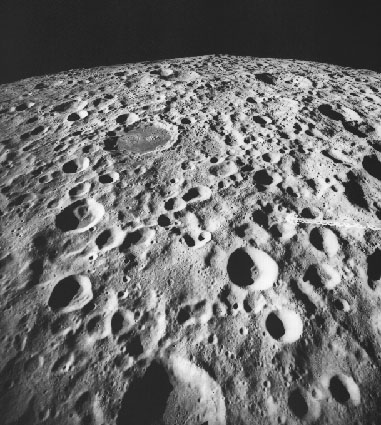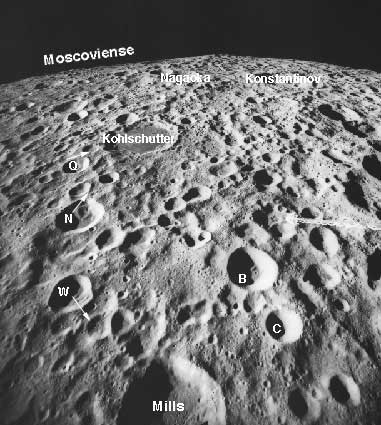Difference between revisions of "July 24, 2004"
| (9 intermediate revisions by the same user not shown) | |||
| Line 1: | Line 1: | ||
__NOTOC__ | __NOTOC__ | ||
=An Excess of Craters= | =An Excess of Craters= | ||
| + | <!-- Start of content --> | ||
<br> | <br> | ||
<table width="85%" border="0" align="center" cellpadding="6" cellspacing="2"> | <table width="85%" border="0" align="center" cellpadding="6" cellspacing="2"> | ||
| Line 9: | Line 10: | ||
<tr> | <tr> | ||
<td colspan="2"><div align="center"> | <td colspan="2"><div align="center"> | ||
| − | + | {{HoverImage|LPOD-2004-07-24.jpeg|LPOD-2004-07-24b.jpeg}} | |
</div></td> | </div></td> | ||
</tr> | </tr> | ||
| Line 15: | Line 16: | ||
<table width="100%" border="0" cellpadding="8"> | <table width="100%" border="0" cellpadding="8"> | ||
<tr> | <tr> | ||
| − | <td><div align="center | + | <td><div align="center"><p>Image Credit: [http://www.lpi.usra.edu/science/kiefer/Education/SSRG2-Craters/craterstructure.html Apollo 16 Metric Frame AS16-M0728]</p></div></td> |
</tr> | </tr> | ||
</table> | </table> | ||
| Line 22: | Line 23: | ||
<p class="story" align="center"><b>An Excess of Craters</b></p> | <p class="story" align="center"><b>An Excess of Craters</b></p> | ||
<p class="story" align="left"> | <p class="story" align="left"> | ||
| − | I worked my way through college by measuring lunar craters for the System of Lunar Craters catalog published by the Lunar & Planetary Lab in the early 1960s. I am glad that this image of the middle of the lunar farside was not available then - it is a crater counter's nightmare! The dark-floored crater - one of the rare example of low albedo maria material far from the Big Backside Basin - is 53 km wide Kohlschutter (14N, 154E) and the entire area is pockmarked with smaller craters. Perhaps this is simply an ancient surface, as suggested by its many craters, but I wonder if the fact that they are mostly 15-30 km wide and appear similar in age means they are basin secondary craters? This area is surrounded by large impact basins - Freundlich-Sharonov to the E, Keeler-Heaviside to the S, Mendeleev to the W and, just visible as a limb flattening, Moscoviense to the N. The problem is all of these basin appear to be older than their putative secondaries! But Wilhelms, in his Geologic History of the Moon (p 85), also interprets this multitude of craters as secondaries and proposes Mendeleev as the source. So, if I'm wrong, I am in great company! | + | I worked my way through college by measuring lunar craters for the System of Lunar Craters catalog published by the Lunar & Planetary Lab in the early 1960s. I am glad that this image of the middle of the lunar farside was not available then - it is a crater counter's nightmare! The dark-floored crater - one of the rare example of low albedo maria material far from the Big Backside Basin - is 53 km wide Kohlschutter (14N, 154E) and the entire area is pockmarked with smaller craters. Perhaps this is simply an ancient surface, as suggested by its many craters, but I wonder if the fact that they are mostly 15-30 km wide and appear similar in age means they are basin secondary craters? This area is surrounded by large impact basins - Freundlich-Sharonov to the E, Keeler-Heaviside to the S, Mendeleev to the W and, just visible as a limb flattening, Moscoviense to the N. The problem is all of these basin appear to be older than their putative secondaries! But Wilhelms, in his Geologic History of the Moon (p 85), also interprets this multitude of craters as secondaries and proposes Mendeleev as the source. So, if I'm wrong, I am in great company!</p> |
<blockquote> | <blockquote> | ||
| − | <p align="right" class="story">— [mailto:tychocrater@yahoo.com Chuck Wood]</ | + | <p align="right" class="story">— [mailto:tychocrater@yahoo.com Chuck Wood]</p></blockquote> |
| − | </ | ||
<p class="story"><b>Related Links:</b> <br> | <p class="story"><b>Related Links:</b> <br> | ||
| − | [ | + | [http://www.lpi.usra.edu/research/lunar_orbiter/images/aimg/v_103_m.jpg Lunar Orbiter V View] </p> |
| − | <p | + | <p><b>Yesterday's LPOD:</b> [[July 23, 2004|Sun, Moon and Stars]] </p> |
| + | <p><b>Tomorrow's LPOD:</b> [[July 25, 2004|Pre-History of the Triesnecker Area]] </p> | ||
</tr> | </tr> | ||
</table> | </table> | ||
| Line 39: | Line 40: | ||
<td><p align="center" class="main_titles"><b>Author & Editor:</b><br> | <td><p align="center" class="main_titles"><b>Author & Editor:</b><br> | ||
[mailto:tychocrater@yahoo.com Charles A. Wood]</p> | [mailto:tychocrater@yahoo.com Charles A. Wood]</p> | ||
| − | < | + | <!-- Cleanup of credits --> |
| − | + | <!-- Cleanup of credits --> | |
| − | < | + | <!-- Cleanup of credits --> |
| − | + | <!-- Cleanup of credits --> | |
| − | < | + | <!-- Cleanup of credits --> |
| − | + | <!-- Cleanup of credits --> | |
| + | <!-- Cleanup of credits --> | ||
</tr> | </tr> | ||
</table> | </table> | ||
<p> </p> | <p> </p> | ||
| − | ---- | + | <!-- End of content --> |
| − | + | {{wiki/ArticleFooter}} | |
| − | |||
Latest revision as of 21:42, 8 February 2015
An Excess of Craters
Image Credit: Apollo 16 Metric Frame AS16-M0728 |
|
An Excess of Craters I worked my way through college by measuring lunar craters for the System of Lunar Craters catalog published by the Lunar & Planetary Lab in the early 1960s. I am glad that this image of the middle of the lunar farside was not available then - it is a crater counter's nightmare! The dark-floored crater - one of the rare example of low albedo maria material far from the Big Backside Basin - is 53 km wide Kohlschutter (14N, 154E) and the entire area is pockmarked with smaller craters. Perhaps this is simply an ancient surface, as suggested by its many craters, but I wonder if the fact that they are mostly 15-30 km wide and appear similar in age means they are basin secondary craters? This area is surrounded by large impact basins - Freundlich-Sharonov to the E, Keeler-Heaviside to the S, Mendeleev to the W and, just visible as a limb flattening, Moscoviense to the N. The problem is all of these basin appear to be older than their putative secondaries! But Wilhelms, in his Geologic History of the Moon (p 85), also interprets this multitude of craters as secondaries and proposes Mendeleev as the source. So, if I'm wrong, I am in great company! Related Links: Yesterday's LPOD: Sun, Moon and Stars Tomorrow's LPOD: Pre-History of the Triesnecker Area |
Author & Editor: |
COMMENTS?
Register, Log in, and join in the comments.





